Assessing the Impact of Lignite-Based Rekulter Fertilizer on Soil Sustainability: A Comprehensive Field Study
Abstract
:1. Introduction
2. Materials and Methods
2.1. Research Materials
2.1.1. Location of the Multi-Year Field Trial
2.1.2. Description of the Experimental Design
2.2. Research Methods
2.2.1. Analysis of the Soil Samples Treated with the Lignite-Based Fertilizer (Rekulter)
2.2.2. Evaluation of Different Parameters’ Measures
- -
- represents the observed value of the soil property for the -th replicate in the -th year, in the -th subfield, and in the -th treatment group (Rekulter treatment variant),
- -
- is the overall mean of the soil property across all treatment groups,
- -
- represents the fixed effect of the -th Rekulter treatment variant,
- -
- represents the fixed effect of the -th subfield,
- -
- represents the interaction effect between Rekulter treatment variant and subfield ,
- -
- represents the fixed effect of the -th year,
- -
- represents the interaction effect between Rekulter treatment variant and year ,
- -
- represents the interaction effect between subfield and year , and
- -
- is the random error term.
- -
- is the Honestly Significant Difference,
- -
- is the critical value from the Studentized Range Distribution table,
- -
- is the Mean Square Within (error variance),
- -
- is the total number of observations,
- -
- is the number of groups being compared.
3. Results
3.1. Physicochemical Properties of Soils
3.1.1. pH Value and Acidity of the Soils
3.1.2. Sorption Properties of Soils
3.1.3. Granulometric Composition of Soils
3.1.4. Soil Fertility and Nutrient Content
3.1.5. Content of PAHs and PCs
3.2. Fractional Composition of Organic Matter
4. Discussion
5. Conclusions
Author Contributions
Funding
Institutional Review Board Statement
Informed Consent Statement
Data Availability Statement
Conflicts of Interest
Appendix A
| Df | Sum Sq | Mean Sq | F Value | Pr (>F) | |
|---|---|---|---|---|---|
| Variant | 11 | 0.2383 | 0.079433 | 0.026725 | 0.99348 |
| Residuals | 56 | 17.83375 | 2.972292 |
| Df | Sum Sq | Mean Sq | F Value | Pr (>F) | |
|---|---|---|---|---|---|
| Variant | 3 | 979.4892 | 326.4964 | 2.239809 | 0.18414 |
| Residuals | 56 | 874.6183 | 145.7697 |
| Df | Sum Sq | Mean Sq | F Value | Pr (>F) | |
|---|---|---|---|---|---|
| Variant | 3 | 0.030225 | 0.010075 | 0.05338 | 0.982709 |
| Residuals | 76 | 1.698675 | 0.188742 |
| Year | Variant/Dose | OC | TN | C:N | ||
|---|---|---|---|---|---|---|
| 1st | K1 | 0.76 | 0.0212 | 0.06 | 0.0042 | 13 |
| 1st | K2 | 1.08 | 0.0170 | 0.08 | 0.0057 | 14 |
| 1st | K3 | 1.45 | 0.0255 | 0.09 | 0.0042 | 16 |
| 1st | K4 | 2.21 | 0.0354 | 0.11 | 0.0071 | 20 |
| 2nd | K1 | 0.77 | 0.0183 | 0.05 | 0.0042 | 15 |
| 2nd | K2 | 1.05 | 0.0156 | 0.07 | 0.0057 | 15 |
| 2nd | K3 | 1.44 | 0.0226 | 0.07 | 0.0042 | 21 |
| 2nd | K4 | 2.17 | 0.0311 | 0.10 | 0.0071 | 22 |
| 3rd | K1 | 0.79 | 0.0198 | 0.05 | 0.0042 | 16 |
| 3rd | K2 | 1.00 | 0.0141 | 0.07 | 0.0057 | 14 |
| 3rd | K3 | 1.35 | 0.0240 | 0.09 | 0.0042 | 15 |
| 3rd | K4 | 2.13 | 0.0339 | 0.11 | 0.0071 | 19 |
| 4th | K1 | 0.84 | 0.0226 | 0.05 | 0.0042 | 17 |
| 4th | K2 | 1.16 | 0.0198 | 0.07 | 0.0057 | 17 |
| 4th | K3 | 1.57 | 0.0283 | 0.08 | 0.0042 | 20 |
| 4th | K4 | 2.26 | 0.0397 | 0.10 | 0.0071 | 23 |
| 5th | K1 | 0.87 | 0.0240 | 0.05 | 0.0042 | 17 |
| 5th | K2 | 1.15 | 0.0226 | 0.07 | 0.0057 | 16 |
| 5th | K3 | 1.50 | 0.0268 | 0.08 | 0.0042 | 19 |
| 5th | K4 | 2.27 | 0.0367 | 0.09 | 0.0071 | 25 |
| 22nd | K1 | 0.76 | 0.0212 | 0.07 | 0.0042 | 11 |
| 22nd | K2 | 1.08 | 0.0170 | 0.08 | 0.0057 | 14 |
| 22nd | K3 | 1.41 | 0.0240 | 0.08 | 0.0042 | 18 |
| 22nd | K4 | 2.17 | 0.0354 | 0.09 | 0.0071 | 24 |
| Df | Sum Sq | Mean Sq | F Value | Pr (>F) | |
|---|---|---|---|---|---|
| Variant | 3 | 98.87743 | 32.95914 | 10.27104 | 0.000012 |
| Residuals | 66 | 211.79 | 3.208939 |
| Pairs | diff | lwr | upr | p adj |
|---|---|---|---|---|
| K2-K1 | 0.157778 | −1.41605 | 1.731608 | 0.993479 |
| K3-K1 | 1.338333 | −0.2355 | 2.912163 | 0.122857 |
| K4-K1 | 2.927222 | 1.353392 | 4.501052 | 0.000039 |
| K3-K2 | 1.180556 | −0.39327 | 2.754385 | 0.207066 |
| K4-K2 | 2.769444 | 1.195615 | 4.343274 | 0.000099 |
| K4-K3 | 1.588889 | 0.015059 | 3.162719 | 0.046993 |
| Df | Sum Sq | Mean Sq | F Value | Pr (>F) | |
|---|---|---|---|---|---|
| Variant | 3 | 36876.83 | 12292.28 | 5.562676 | 0.009057 |
| Residuals | 114 | 33146.67 | 2209.778 |
| Pairs | diff | lwr | upr | p adj. |
|---|---|---|---|---|
| K2-K1 | −76.1667 | −154.389 | 2.055538 | 0.048602 |
| K3-K1 | −103 | −181.222 | −24.7778 | 0.008517 |
| K4-K1 | −83.8333 | −162.056 | −5.61113 | 0.033777 |
| K3-K2 | −26.8333 | −105.056 | 51.38887 | 0.757946 |
| K4-K2 | −7.66667 | −85.8889 | 70.55554 | 0.991804 |
| K4-K3 | 19.16667 | −59.0555 | 97.38887 | 0.893066 |
| Df | Sum Sq | Mean Sq | F Value | Pr (>F) | |
|---|---|---|---|---|---|
| Variant | 3 | 106.9017 | 35.63391 | 8.97283 | 0.000214 |
| Residuals | 209 | 119.1394 | 3.971312 |
| Variant | diff | lwr | upr | p adj |
|---|---|---|---|---|
| K2-K1 | 0.542727 | −1.76781 | 2.853261 | 0.918627 |
| K3-K1 | 2.035455 | −0.27508 | 4.345988 | 0.099711 |
| K4-K1 | 4.020909 | 1.710375 | 6.331443 | 0.000277 |
| K3-K2 | 1.492727 | −0.81781 | 3.803261 | 0.313505 |
| K4-K2 | 3.478182 | 1.167648 | 5.788716 | 0.001598 |
| K4-K3 | 1.985455 | −0.32508 | 4.295988 | 0.112241 |
| Df | Sum Sq | Mean Sq | F Value | Pr(>F) | |
|---|---|---|---|---|---|
| Variant | 3 | 316.1008 | 105.3669 | 3.876915 | 0.019951 |
| Residuals | 209 | 733.8067 | 27.17803 |
| Variant | diff | lwr | upr | p adj. |
|---|---|---|---|---|
| K2-K1 | −6.69 | −13.0701 | −0.30987 | 0.037241 |
| K3-K1 | −2.36 | −8.74013 | 4.02013 | 0.743727 |
| K4-K1 | −6.4 | −12.7801 | −0.01987 | 0.049077 |
| K3-K2 | 4.33 | −2.05013 | 10.71013 | 0.269815 |
| K4-K2 | 0.29 | −6.09013 | 6.67013 | 0.999294 |
| K4-K3 | −4.04 | −10.4201 | 2.34013 | 0.327021 |
References
- Sofo, A.; Zanella, A.; Ponge, J.F. Soil quality and fertility in sustainable agriculture, with a contribution to the biological classification of agricultural soils. Soil Use Manag. 2022, 38, 1085–1112. [Google Scholar] [CrossRef]
- Havlin, J.; Heiniger, R. Soil Fertility Management for Better Crop Production. Agronomy 2020, 10, 1349. [Google Scholar] [CrossRef]
- Kibret, K.; Beyene, S.; Erkossa, T. Soil Fertility and Soil Health; Springer International Publishing: Cham, Switzerland, 2023; pp. 157–192. [Google Scholar]
- Pozza, L.E.; Field, D.J. The science of soil security and food security. Soil Secur. 2020, 1, 100002. [Google Scholar] [CrossRef]
- Lehmann, J.; Bossio, D.A.; Kögel-Knabner, I.; Rillig, M.C. The concept and future prospects of soil health. Nat. Rev. Earth Environ. 2020, 1, 544–553. [Google Scholar] [CrossRef]
- Thapa, S.; Bhandari, A.; Ghimire, R.; Xue, Q.; Kidwaro, F.; Ghatrehsamani, S.; Goodwin, M. Managing micronutrients for improving soil fertility, health, and soybean yield. Sustainability 2021, 13, 11766. [Google Scholar] [CrossRef]
- Akimbekov, N.S.; Digel, I.; Tastambek, K.T.; Sherelkhan, D.K.; Jussupova, D.B.; Altynbay, N.P. Low-rank coal as a source of humic substances for soil amendment and fertility management. Agriculture 2021, 11, 1261. [Google Scholar] [CrossRef]
- Ciarkowska, K.; Sołek-Podwika, K.; Filipek-Mazur, B.; Tabak, M. Comparative effects of lignite-derived humic acids and FYM on soil properties and vegetable yield. Geoderma 2017, 303, 85–92. [Google Scholar] [CrossRef]
- Dębska, B.; Maciejewska, A.; Kwiatkowska, J. The effect of fertilization with brown coal on Haplic Luvisol humic acids. Plant Soil Environ. 2011, 48, 33–39. [Google Scholar] [CrossRef]
- Kumar Dewangan, S.; Kumari, L.; Minj, P.; Kumari, J.; Sahu, R. The effects of soil ph on soil health and environmental sustainability: A review. Int. J. Emerg. Technol. Innov. Res. 2023, 10, 611–616. [Google Scholar]
- Cui, J.; Yang, B.; Zhang, M.; Song, D.; Xu, X.; Ai, C.; Zhou, W. Investigating the effects of organic amendments on soil microbial composition and its linkage to soil organic carbon: A global meta-analysis. Sci. Total Environ. 2023, 1, 164899. [Google Scholar] [CrossRef]
- Agim, L.C.; Arinzechukwu, I.C.; Osisi, A.F.; Chris-Emenyonu, C.M. Effect of organic amendment on properties and nutrient loss of soils of selected parent material. Eurasian J. Soil Sci. 2020, 9, 329–338. [Google Scholar] [CrossRef]
- Głąb, T.; Gondek, K.; Marcińska-Mazur, L.; Jarosz, R.; Mierzwa–Hersztek, M. Effect of organic/inorganic composites as soil amendments on the biomass productivity and root architecture of spring wheat and rapeseed. J. Environ. Manag. 2023, 344, 118628. [Google Scholar] [CrossRef] [PubMed]
- Muneer, M.A.; Hou, W.; Li, J.; Huang, X.; ur Rehman Kayani, M.; Cai, Y.; Zheng, C. Soil pH: A key edaphic factor regulating distribution and functions of bacterial community along vertical soil profiles in red soil of pomelo orchard. BMC Microbiol. 2022, 22, 38. [Google Scholar] [CrossRef] [PubMed]
- Rashid, M.; Hussain, Q.; Hayat, R.; Ahmed, M.; Islam, M.S.; Soufan, W.; El Sabagh, A. Lignite Scaffolding as Slow-Release N-Fertilizer Extended the SN Retention and Inhibited N Losses in Alkaline Calcareous Soils. ACS Omega 2023, 8, 22732–22741. [Google Scholar] [CrossRef] [PubMed]
- Bariş, H.; Dincer, S. Lignite-based nitrogenous fertilizers. Energy Sources 1983, 7, 87–94. [Google Scholar] [CrossRef]
- Amoah-Antwi, C.; Kwiatkowska-Malina, J.; Fenton, O.; Szara, E.; Thornton, S.F.; Malina, G. Holistic assessment of biochar and brown coal waste as organic amendments in sustainable environmental and agricultural applications. Water Air Soil Pollut. 2021, 232, 106. [Google Scholar] [CrossRef]
- Maciejewska, A.; Kwiatkowska-Malina, J. Elucidating the effect and mechanism of the brown coal-based amendment on plant availability of zinc, lead and cadmium in a Haplic Luvisols. Environ. Sci. Pollut. Res. 2022, 29, 23383–23391. [Google Scholar] [CrossRef]
- Amoah-Antwi, C.; Kwiatkowska-Malina, J.; Thornton, S.F.; Fenton, O.; Malina, G.; Szara, E. Restoration of soil quality using biochar and brown coal waste: A review. Sci. Total Environ. 2020, 722, 137852. [Google Scholar] [CrossRef]
- Kwiatkowska, J.; Provenzano, M.R.; Senesi, N. Long term effects of a brown coal-based amendment on the properties of soil humic acids. Geoderma 2008, 148, 200–205. [Google Scholar] [CrossRef]
- Kwiatkowska-Malina, J. Functions of organic matter in polluted soils: The effect of organic amendments on phytoavailability of heavy metals. Appl. Soil Ecol. 2018, 123, 542–545. [Google Scholar] [CrossRef]
- FAO. Standard Operating Procedure for Soil pH Determination; Food and Agriculture Organization of the United Nations: Rome, Italy, 2021. [Google Scholar]
- Sparks, D.L.; Page, A.L.; Helmke, P.A.; Loeppert, R.H. Methods of Soil Analysis, Part 3: Chemical Methods; John Wiley & Sons: Hoboken, NJ, USA, 2020. [Google Scholar]
- Msimbira, L.A.; Smith, D.L. The roles of plant growth promoting microbes in enhancing plant tolerance to acidity and alkalinity stresses. Front. Sustain. Food Syst. 2020, 4, 106. [Google Scholar] [CrossRef]
- Parikh, S.J.; James, B.R. Soil: The foundation of agriculture. Nat. Educ. Knowl. 2012, 3, 2. [Google Scholar]
- Albano, X.; Whitmore, A.P.; Sakrabani, R.; Thomas, C.L.; Sizmur, T.; Ritz, K.; Haefele, S.M. Effect of different organic amendments on actual and achievable yields in a cereal-based cropping system. J. Soil Sci. Plant Nutr. 2023, 1, 1–16. [Google Scholar] [CrossRef]
- Larney, F.J.; Angers, D.A. The role of organic amendments in soil reclamation: A review. Can. J. Soil Sci. 2012, 92, 19–38. [Google Scholar] [CrossRef]
- Dong, L.; Zhang, W.; Xiong, Y.; Zou, J.; Huang, Q.; Xu, X.; Huang, G. Impact of short-term organic amendments incorporation on soil structure and hydrology in semiarid agricultural lands. Int. Soil Water Conserv. Res. 2022, 10, 457–469. [Google Scholar] [CrossRef]
- Traunfeld, J. Organic Matter and Soil Amendments. University of Maryland. Available online: https://extension.umd.edu/resource/organic-matter-and-soil-amendments/ (accessed on 15 January 2023).
- Su, J.Y.; Liu, C.H.; Tampus, K.; Lin, Y.C.; Huang, C.H. Organic amendment types influence soil properties, the soil bacterial microbiome, and tomato growth. Agronomy 2022, 12, 1236. [Google Scholar] [CrossRef]
- Li, X.; Zhu, W.; Xu, F.; Du, J.; Tian, X.; Shi, J.; Wei, G. Organic amendments affect soil organic carbon sequestration and fractions in fields with long-term contrasting nitrogen applications. Agric. Ecosyst. Environ. 2021, 322, 107643. [Google Scholar] [CrossRef]
- Yang, Y.; Zhang, N.; Xue, M.; Tao, S. Impact of soil organic matter on the distribution of polycyclic aromatic hydrocarbons (PAHs) in soils. Environ. Pollut. 2010, 158, 2170–2174. [Google Scholar] [CrossRef]
- Hayes, M.H.; Swift, R.S. Vindication of humic substances as a key component of organic matter in soil and water. Agronomy 2020, 163, 1–37. [Google Scholar]
- Hriciková, S.; Kožárová, I.; Hudáková, N.; Reitznerová, A.; Nagy, J.; Marcinčák, S. Humic Substances as a Versatile Intermediary. Life 2023, 13, 858. [Google Scholar] [CrossRef]
- Lanno, M.; Klavins, M.; Purmalis, O.; Shanskiy, M.; Kisand, A.; Kriipsalu, M. Properties of Humic Substances in Composts Comprised of Different Organic Source Material. Agriculture 2022, 12, 1797. [Google Scholar] [CrossRef]
- Ampong, K.; Thilakaranthna, M.S.; Gorim, L.Y. Understanding the role of humic acids on crop performance and soil health. Front. Agron. 2022, 4, 848621. [Google Scholar] [CrossRef]
- Trevisan, S.; Francioso, O.; Quaggiotti, S.; Nardi, S. Humic substances biological activity at the plant-soil interface: From environmental aspects to molecular factors. Plant Signal. Behav. 2010, 5, 635–643. [Google Scholar] [CrossRef]
- Wadoux, A.M.C.; Román-Dobarco, M.; McBratney, A.B. Perspectives on data-driven soil research. Eur. J. Soil Sci. 2021, 72, 1675–1689. [Google Scholar] [CrossRef]
- Loncaric, Z.; Kovacevic, V.; Rastija, D.; Karalic, K.; Popovic, B.; Ivezic, V.; Semialjac, Z. Simple regression models for predicting soil hydrolytic acidity. Eur. Sci. J. 2013, 3, 173–179. [Google Scholar]
- FAO. Standard Operating Procedure for Soil Organic Carbon Tyurin Spectrophotometric Method; Food and Agriculture Organization of the United Nations: Rome, Italy, 2021. [Google Scholar]
- Sáez-Plaza, P.; Navas, M.J.; Wybraniec, S.; Michałowski, T.; Asuero, A.G. An overview of the Kjeldahl method of nitrogen determination. Part II. Sample preparation, working scale, instrumental finish, and quality control. Crit. Rev. Anal. Chem. 2013, 43, 224–272. [Google Scholar] [CrossRef]
- Black, C.A.; Evans, D.D.; White, J.L. Methods of Soil Analysis. Part 1. Physical and Mineralogical Properties, Including Statistics of Measurement and Sampling, Agronomy Monograph 9.1; American Society of Agronomy (ASA): Madison, WI, USA, 1965. [Google Scholar]
- Warzyński, H.; Sosnowska, A.; Harasimiuk, A. Effect of variable content of organic matter and carbonates on results of determination of granulometric composition by means of Casagrande’s areometric method in modification by Prószyński. Soil Sci. Annu. 2018, 69, 39. [Google Scholar] [CrossRef]
- Jeffery, J.; Carradus, M.; Songin, K.; Pettit, M.; Pettit, K.; Wright, C. Optimized method for determination of 16 FDA polycyclic aromatic hydrocarbons (PAHs) in mainstream cigarette smoke by gas chromatography–mass spectrometry. Chem. Cent. J. 2018, 12, 27. [Google Scholar] [CrossRef]
- Newman, M.E. Ranking with multiple types of pairwise comparisons. Proc. R. Soc. A 2022, 478, 20220517. [Google Scholar] [CrossRef]
- Midway, S.; Robertson, M.; Flinn, S.; Kaller, M. Comparing multiple comparisons: Practical guidance for choosing the best multiple comparisons test. PeerJ 2020, 8, e10387. [Google Scholar] [CrossRef]
- Lee, S.; Lee, D.K. What is the proper way to apply the multiple comparison test? Korean J. Anesthesiol. 2018, 71, 353–360. [Google Scholar] [CrossRef]
- Okeke, O.K.; Isah, A.D.; Shamaki, S.B.; Abubakar, G.A.; Nolisa, M.U.; Umar, Z. Assessment of Soil Organic Carbon and Total Nitrogen as Indicators for Soil Productivity in Gidan Amamata Eucalyptus (Eucalyptus globulus) Plantation, Sokoto State, Nigeria. J. Agric. Environ. 2022, 18, 107–114. [Google Scholar]
- Gerke, J. The Central Role of Soil Organic Matter in Soil Fertility and Carbon Storage. Soil Syst. 2022, 6, 33. [Google Scholar] [CrossRef]
- Wibowo, H.; Kasno, A. Soil organic carbon and total nitrogen dynamics in paddy soils on the Java Island, Indonesia. In Proceedings of the 1st International Conference on Sustainable Tropical Land Management, Bogor, Indonesia, 16–18 September 2020. [Google Scholar]
- Li, C.; Aluko, O.O.; Yuan, G.; Li, J.; Liu, H. The responses of soil organic carbon and total nitrogen to chemical nitrogen fertilizers reduction base on a meta-analysis. Sci. Rep. 2022, 12, 16326. [Google Scholar] [CrossRef] [PubMed]
- KBS LTER. Soil Total Carbon and Nitrogen, Michigan State University. Available online: https://lter.kbs.msu.edu/protocols/37 (accessed on 2 April 2024).
- Ghosal, D.; Ghosh, S.; Dutta, T.K.; Ahn, Y. Current state of knowledge in microbial degradation of polycyclic aromatic hydrocarbons (PAHs): A review. Front. Microbiol. 2016, 7, 1–27. [Google Scholar] [CrossRef] [PubMed]
- Molina, L.; Segura, A. Biochemical and metabolic plant responses toward polycyclic aromatic hydrocarbons and heavy metals present in atmospheric pollution. Plants 2021, 10, 2305. [Google Scholar] [CrossRef] [PubMed]
- Arafat, S.M.; Aboelghar, M.A.; Ahmed, E.F. Crop Discrimination Using Field Hyper Spectral Remotely Sensed Data. Adv. Remote Sens. 2013, 2, 63–70. [Google Scholar] [CrossRef]
- Salisu, A.; Abubakar, H.; Abubakar, H. One way anova: Concepts and application in agricultural system. In Proceedings of the CEUR Workshop Proceedings, Kaunas, Lithuania, 27 April 2018. [Google Scholar]
- Bello, P.; Bradford, K.J. Relationships of Brassica seed physical characteristics with germination performance and plant blindness. Agriculture 2021, 11, 220. [Google Scholar] [CrossRef]
- Ireland, C. Non-Parametric Sample Comparison Tests. Experimental Statistics for Agriculture and Horticulture; Writtle College: Chelmsford, Essex, UK, 2010; pp. 181–200. [Google Scholar]
- Turechek, W.W. Nonparametric tests in plant disease epidemiology: Characterizing disease associations. Phytopathology 2004, 94, 1018–1021. [Google Scholar] [CrossRef]
- Bittner, A.C. Analysis-of-variance (ANOVA) Assumptions Review: Normality, Variance Equality, and Independence. In Proceedings of the XXXIVth Annual International Occupational Ergonomics and Safety Conference, Virtual Conference, 15–16 September 2022. [Google Scholar]
- Maldybayev, G.; Korabayev, A.; Sharipov, R.; Al Azzam, K.M.; Negim, E.S.; Baigenzhenov, O.; Shayakhmetova, R. Processing of titanium-containing ores for the production of titanium products: A comprehensive review. Heliyon 2024, 10, e24966. [Google Scholar] [CrossRef]
- Smith, K.A.; Mullins, C.E. Soil Analysis: Physical Methods; Marcel Dekker Inc.: New York, NY, USA, 1991. [Google Scholar]
- Lal, R. Restoring soil quality to mitigate soil degradation. Sustainability 2015, 7, 5875–5895. [Google Scholar] [CrossRef]
- Kwiatkowska-Malina, J. The influence of exogenic organic matter on selected chemical and physicochemical properties of soil. Pol. J. Soil Sci. 2016, 48, 173. [Google Scholar] [CrossRef]
- Von Wandruszka, R. Humic acids: Their detergent qualities and potential uses in pollution remediation. Geochem. Trans. 2000, 1, 10. [Google Scholar] [CrossRef]
- Zhang, X.; Amelung, W. Gas chromatographic determination of muramic acid, glucosamine, mannosamine, and galactosamine in soils. Soil Biol. Biochem. 1996, 28, 1201–1206. [Google Scholar] [CrossRef]
- Gerke, J. Concepts and misconceptions of humic substances as the stable part of soil organic matter: A review. Agronomy 2018, 8, 76. [Google Scholar] [CrossRef]
- Badri, D.V.; Chaparro, J.M.; Zhang, R.; Shen, Q.; Vivanco, J.M. Application of natural blends of phytochemicals derived from the root exudates of Arabidopsis to the soil reveal that phenolic-related compounds predominantly modulate the soil microbiome. J. Biol. Chem. 2013, 288, 4502–4512. [Google Scholar] [CrossRef] [PubMed]
- Ma, X.; Zhang, X.; Xia, J.; Sun, H.; Zhang, X.; Ye, L. Phenolic compounds promote the horizontal transfer of antibiotic resistance genes in activated sludge. Sci. Total Environ. 2021, 800, 149549. [Google Scholar] [CrossRef] [PubMed]
- Fan, D.; Zhao, Z.; Wang, Y.; Ma, J.; Wang, X. Crop-type-driven changes in polyphenols regulate soil nutrient availability and soil microbiota. Front. Microbiol. 2022, 13, 964039. [Google Scholar] [CrossRef]
- Ahangar, A.G. Sorption of PAHs in the soil environment with emphasis on the role of soil organic matter: A review. World Appl. Sci. J. 2010, 11, 759–765. [Google Scholar]
- Venkatraman, G.; Giribabu, N.; Mohan, P.S.; Muttiah, B.; Govindarajan, V.; Alagiri, M.; Karsani, S.A. Environmental impact and human health effects of polycyclic aromatic hydrocarbons and remedial strategies: A detailed review. Chemosphere 2024, 1, 141227. [Google Scholar] [CrossRef]
- Aguilera, E.; Lassaletta, L.; Gattinger, A.; Gimeno, B.S. Managing soil carbon for climate change mitigation and adaptation in Mediterranean cropping systems: A meta-analysis. Agric. Ecosyst. Environ. 2013, 168, 25–36. [Google Scholar] [CrossRef]
- Sánchez-Monedero, M.A.; Roig, A.; Paredes, C.; Bernal, M.P. Nitrogen transformation during organic waste composting by the Rutgers system and its effects on pH, EC and maturity of the composting mixtures. Bioresour. Technol. 2001, 78, 301–308. [Google Scholar] [CrossRef] [PubMed]
- West, T.O.; Post, W.M. Soil organic carbon sequestration rates by tillage and crop rotation: A global data analysis. Soil Sci. Soc. Am. J. 2002, 66, 1930–1946. [Google Scholar] [CrossRef]
- Smith, P.; Martino, D.; Cai, Z.; Gwary, D.; Janzen, H.; Kumar, P.; McCarl, B.; Ogle, S.; O’Mara, F.; Rice, C.; et al. Agriculture. In Climate Change 2007: Mitigation. Contribution of Working Group III to the Fourth Assessment Report of the Intergovernmental Panel on Climate Change; Metz, B., Davidson, O.R., Bosch, P.R., Dave, R., Meyer, L.A., Eds.; Cambridge University Press: Cambridge, UK; New York, NY, USA, 2007. [Google Scholar]
- Lityński, T.; Jurkowska, H.; Pycela, Z. II Wartość nawozowa krajowego węgla brunatnego. Przemysł Chem. 1952, 12, 7–8. [Google Scholar]
- Jurkowska, H. Wpływ nawożenia węglem brunatnym i siarczanem miedzi na wysokość i jakość plonu tytoniu. Zesz. Nauk. Roln. WSR Kraków 1962, 10, 1–16. [Google Scholar]
- Farhangi-Abriz, S.; Nikpour-Rashidabad, N. Effect of lignite on alleviation of salt toxicity in soybean (Glycine max L.) plants. Plant Physiol. Biochem. 2017, 120, 186–193. [Google Scholar] [CrossRef]
- Maciejewska, A.; Kuzak, Ł.; Sobieraj, J.; Metelski, D. The Impact of Opencast Lignite Mining on Rural Development: A Literature Review and Selected Case Studies Using Desk Research, Panel Data and GIS-Based Analysis. Energies 2022, 15, 5402. [Google Scholar] [CrossRef]
- Panzella, L.; Napolitano, A. Natural phenol polymers: Recent advances in food and health applications. Antioxidants 2017, 6, 30. [Google Scholar] [CrossRef] [PubMed]
- John, R.C.; Essien, J.P.; Akpan, S.B.; Okpokwasili, G.C. Polycyclic aromatic hydrocarbon-degrading bacteria from aviation fuel spill site at Ibeno, Nigeria. Bull. Environ. Contam. Toxicol. 2012, 88, 1014–1019. [Google Scholar] [CrossRef]
- Peng, R.H.; Xiong, A.S.; Xue, Y.; Fu, X.Y.; Gao, F.; Zhao, W.; Yao, Q.H. Microbial biodegradation of polyaromatic hydrocarbons. FEMS Microbiol. Rev. 2008, 32, 927–955. [Google Scholar] [CrossRef]
- Picariello, E.; Baldantoni, D.; De Nicola, F. Acute effects of PAH contamination on microbial community of different forest soils. Environ. Pollut. 2020, 262, 114378. [Google Scholar] [CrossRef] [PubMed]
- Abdel-Shafy, H.I.; Mansour, M.S. A review on polycyclic aromatic hydrocarbons: Source, environmental impact, effect on human health and remediation. Egypt. J. Pet. 2016, 25, 107–123. [Google Scholar] [CrossRef]
- Thacharodi, A.; Hassan, S.; Singh, T.; Mandal, R.; Khan, H.A.; Hussain, M.A.; Pugazhendhi, A. Bioremediation of polycyclic aromatic hydrocarbons: An updated microbiological review. Chemosphere 2023, 328, 138498. [Google Scholar] [CrossRef] [PubMed]
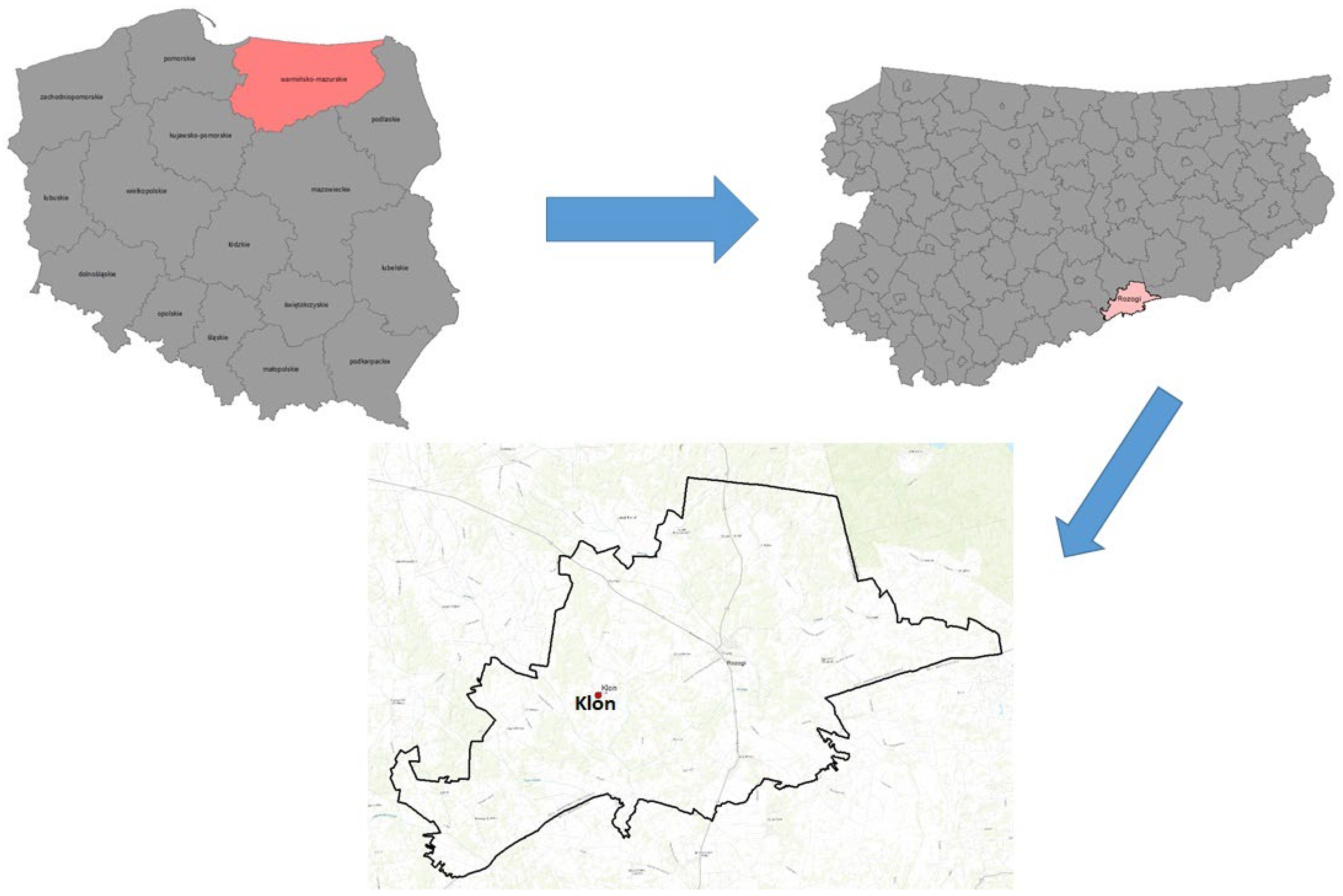


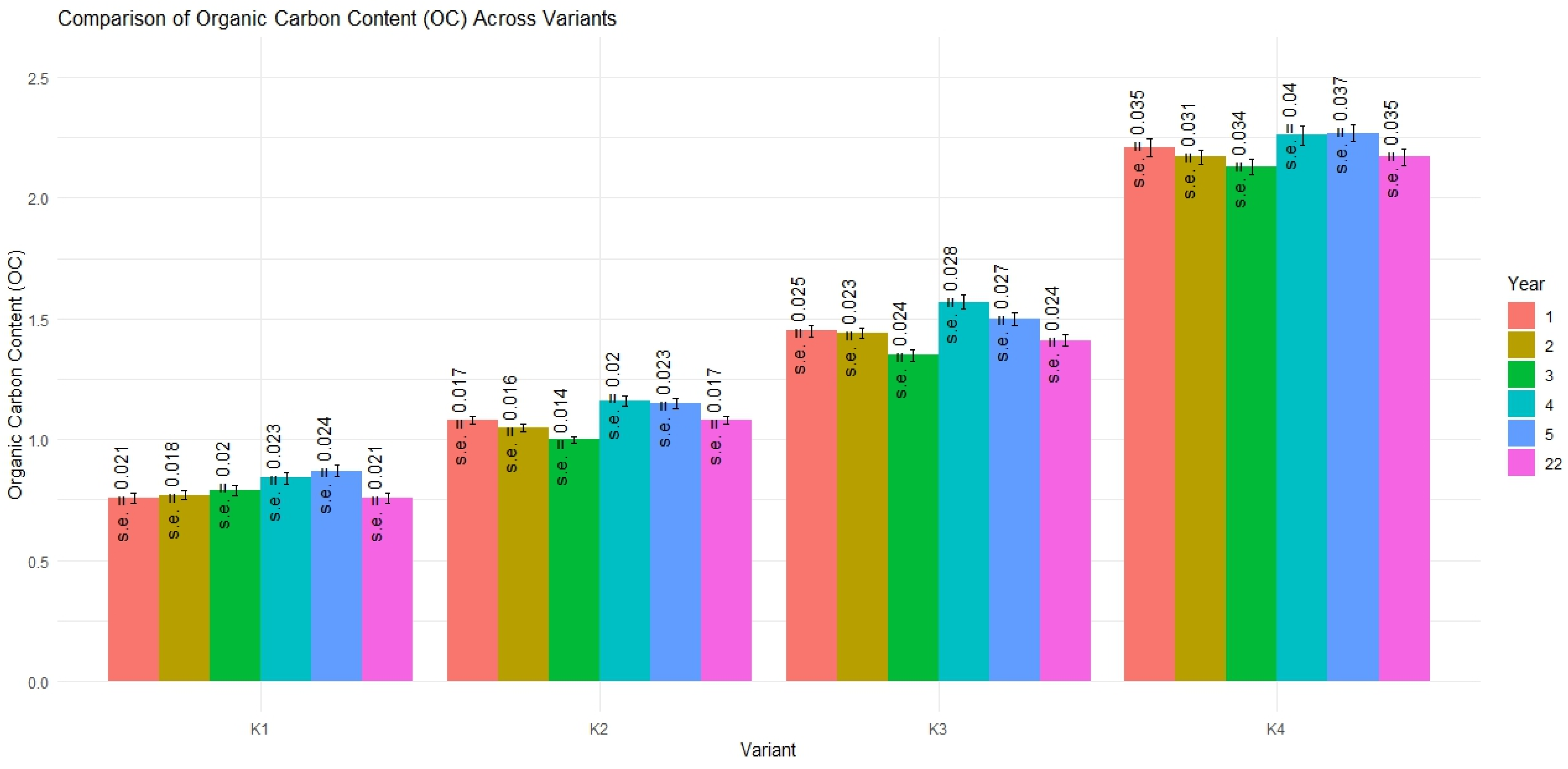
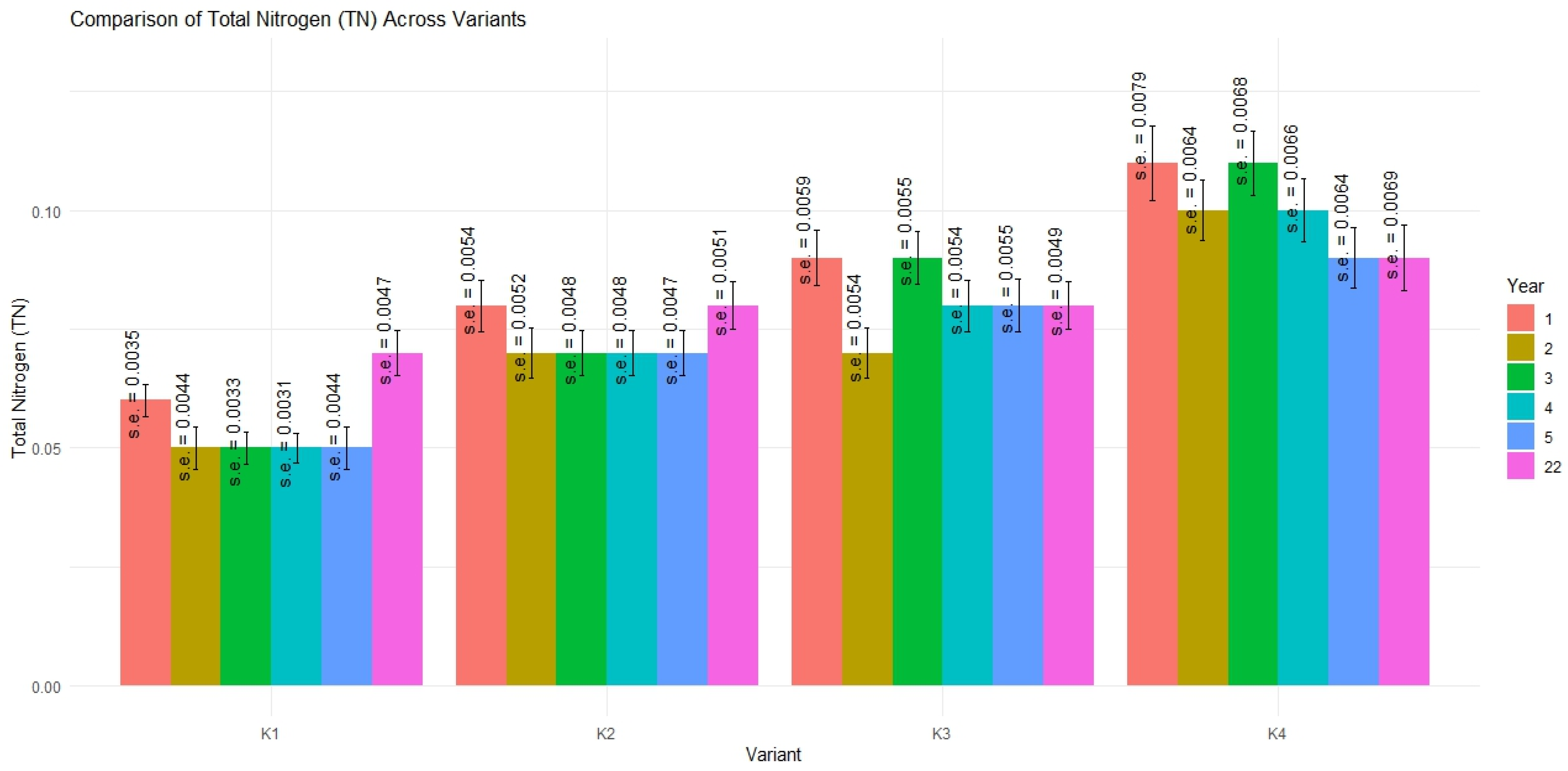

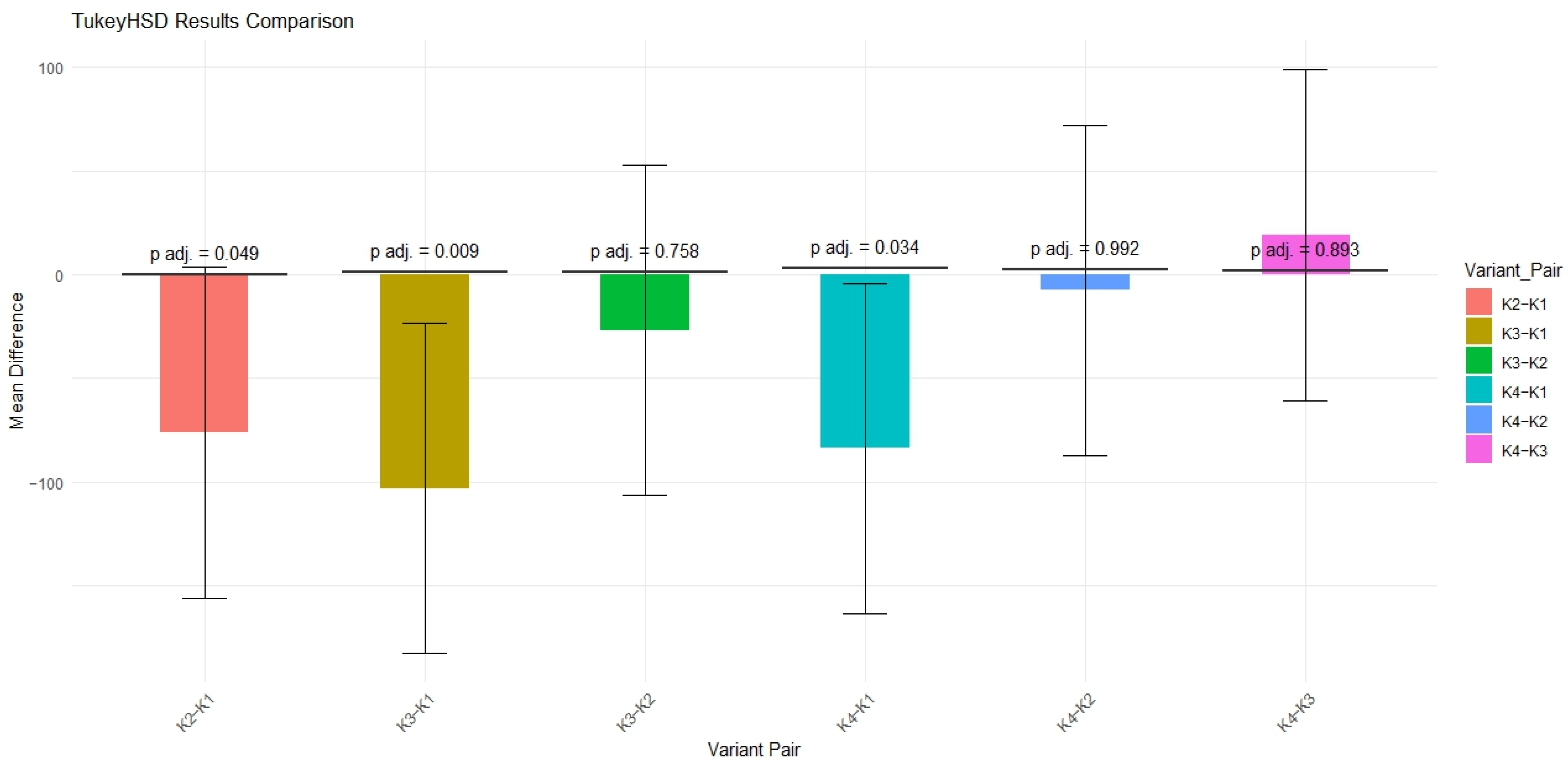
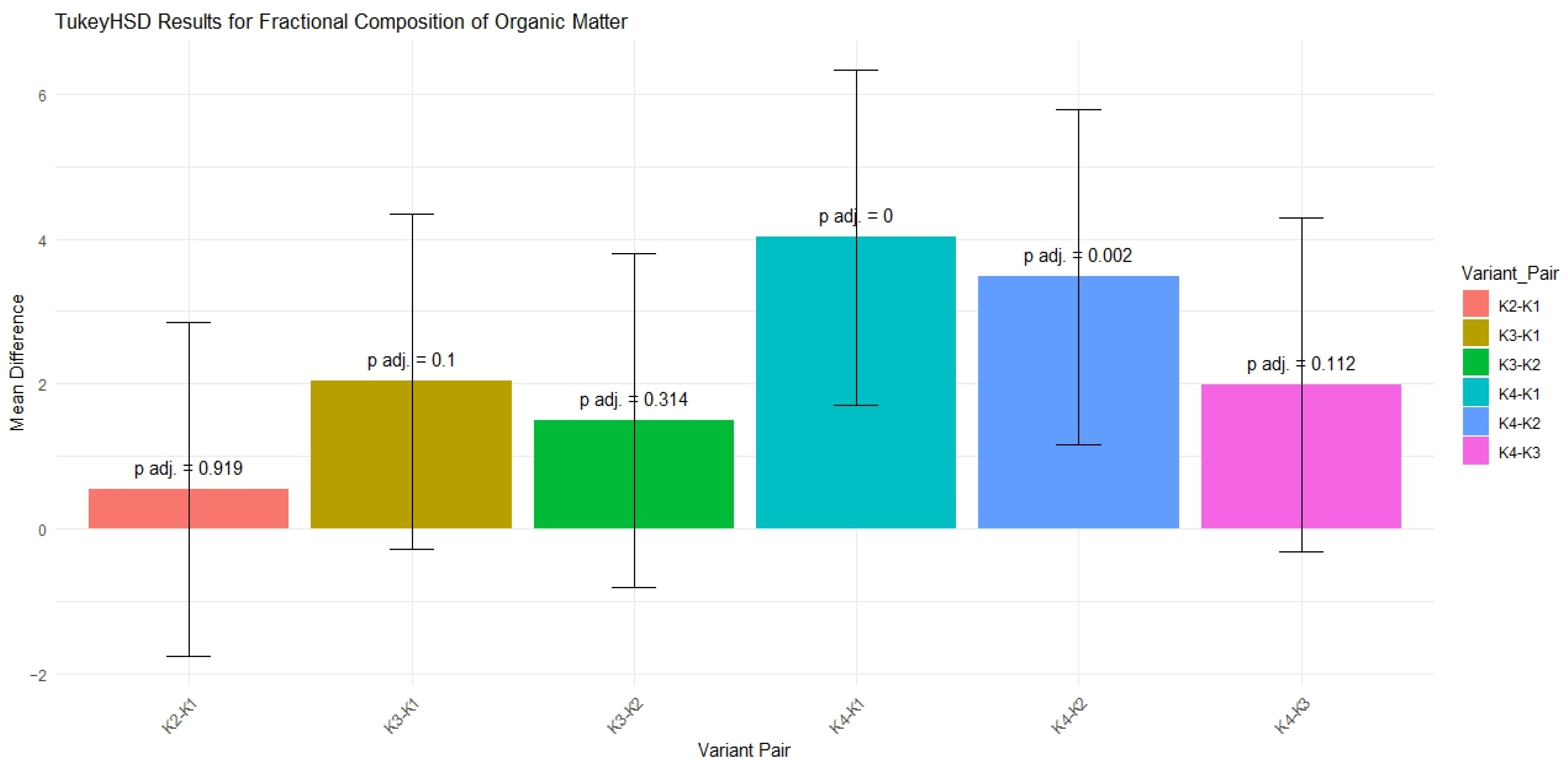
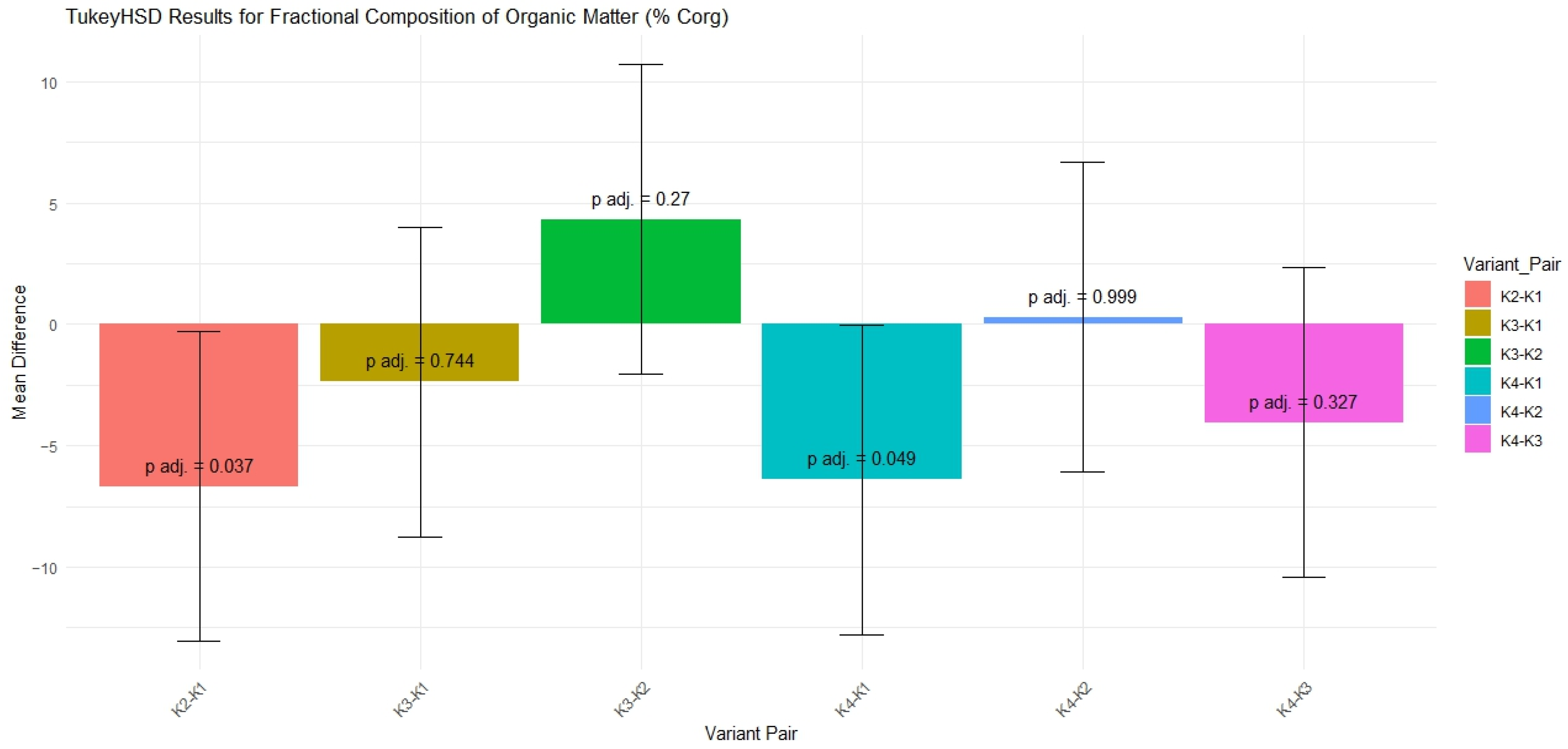
| Dose (Symbol) | pHH2O (SE) | pHKCl (SE) | Hydrolytic Acidity cmol(+). kg−1 (SE) |
|---|---|---|---|
| Control (K1) | 4.90 (0.0071) | 3.76 (0.0042) | 5.80 (0.0141) |
| Low (K2) | 5.10 (0.0057) | 4.10 (0.0028) | 4.08 (0.0113) |
| Medium (K3) | 5.66 (0.0042) | 5.35 (0.0057) | 2.90 (0.0085) |
| High (K4) | 6.75 (0.0085) | 6.05 (0.0071) | 0.93 (0.0057) |
| Dose (Symbol) | S (cmol(+). kg−1) (SE) | T cmol(+). kg−1 (SE) | V (%) (SE) |
|---|---|---|---|
| Control (K1) | 3.6 (0.097) | 9.4 (0.211) | 37 (0.849) |
| Low (K2) | 5.7 (0.118) | 9.8 (0.219) | 62 (0.992) |
| Medium (K3) | 11.8 (0.101) | 14.7 (0.202) | 80 (0.849) |
| High (K4) | 13.2 (0.131) | 14.1 (0.221) | 93 (1.131) |
| Dose (Symbol) | Fractional Content % | Granulometric Groups | |||
|---|---|---|---|---|---|
| Skeletal Particles (SE) | Earthen Particles Ø mm | ||||
| Sand1-0.1 (SE) | Silt0.1-0.02 (SE) | Floatable Particles < 0.02 (SE) | |||
| Control (K1) | 1.48 (0.0035) | 89.5 (0.034) | 6.0 (0.0023) | 4.5 (0.002) | loose sand |
| Low (K2) | 1.49 (0.0037) | 89.8 (0.035) | 6.0 (0.0026) | 4.2 (0.0022) | loose sand |
| Medium (K3) | 1.50 (0.004) | 89.7 (0.037) | 6.0 (0.0024) | 4.3 (0.0023) | loose sand |
| High (K4) | 1.53 (0.0042) | 88.5 (0.03) | 6.0 (0.0027) | 5.5 (0.0029) | weak loamy sand |
| Dose (Symbol) | ∑3-Rings | ∑4-Rings | ∑5-Rings | ∑6-Rings | ∑17 PAHs | |||||
|---|---|---|---|---|---|---|---|---|---|---|
| PY (SE) | LY (SE) | PY (SE) | LY (SE) | PY (SE) | LY (SE) | PY (SE) | LY (SE) | PY (SE) | LY (SE) | |
| Control (K1) | 42 (2.12) | 35 (2.47) | 186 (4.39) | 74 (2.93) | 122 (3.55) | 46 (2.37) | 58 (1.84) | 32 (1.56) | 408 (9.61) | 187 (5.38) |
| Low (K2) | 29 (1.98) | - | 67 (1.70) | - | 57 (1.41) | - | 33 (1.27) | - | 186 (4.52) | - |
| Medium (K3) | 16 (1.13) | - | 37 (0.99) | - | 36 (1.11) | - | 23 (0.71) | - | 112 (3.82) | - |
| High (K4) | 21 (1.84) | 34 (2.14) | 62 (1.70) | 47 (2.40) | 53 (1.56) | 40 (2.26) | 31 (1.41) | 28 (1.84) | 167 (3.11) | 149 (3.39) |
| Dose (Symbol) | phenol (SE) | 2-chlorophenol (SE) | 2,4-dichloro phenol (SE) | 4-chloro-3-methyl phenol (SE) | 2,4,6-trichloro phenol (SE) | penta chloro phenol (SE) | ||||
| Control (K1) | 14 (1.97) | <0.1 - | <0.1 - | <0.2 - | <0.2 - | <1.0 - | ||||
| Low (K2) | 19 (2.69) | <0.1 - | <0.1 - | <0.2 - | <0.2 - | <1.0 - | ||||
| Medium (K3) | 70 (9.76) | <0.1 - | <0.1 - | <0.2 - | <0.2 - | <1.0 - | ||||
| High (K4) | 76 (10.74) | <0.1 - | <0.1 - | <0.2 - | <0.2 - | <1.0 - | ||||
| Dose (Symbol) | OC (SE) | Cdeka (SE) | Extraction with 0.1 M NaOH after Decalcification | Heat-Treated Extraction with 0.02 M NaOH | Sum of Fractions | ||||||
|---|---|---|---|---|---|---|---|---|---|---|---|
| CKH + CKF (SE) | CKH (SE) | CKF (SE) | CKH + CKF (SE) | CKH (SE) | CKF (SE) | CKH + CKF (SE) | CKH (SE) | CKF (SE) | |||
| Control (K1) | 7.6 (0.283) | 0.83 (0.014) | 2.92 - | 1.55 (0.511) | 1.37 (0.281) | 2.81 - | 1.71 (0.294) | 1.10 (0.162) | 5.73 - | 3.26 (0.294) | 2.47 (0.162) |
| Low (K2) | 10.8 (0.324) | 1.08 (0.018) | 3.43 - | 2.44 (0.446) | 0.99 (0.216) | 2.93 - | 2.12 (0.257) | 0.81 (0.141) | 6.36 - | 4.56 (0.257) | 1.80 (0.141) |
| Medium (K3) | 14.1 (0.373) | 0.55 (0.022) | 5.55 - | 4.47 (0.674) | 1.08 (0.191) | 4.50 - | 3.39 (0.388) | 1.11 (0.214) | 8.94 - | 7.86 (0.388) | 2.19 (0.214) |
| High (K4) | 21.7 (0.483) | 0.80 (0.027) | 7.42 - | 6.51 (0.884) | 0.91 (0.217) | 5.85 - | 4.95 (0.508) | 0.90 (0.113) | 13.27 - | 11.46 (0.508) | 1.81 (0.280) |
| Dose (Symbol) | Cdeka (SE) | Extraction with 0.1 M NaOH | Heat-Treated Extraction with 0.02 M NaOH | Sum of Fractions | Pp (SE) | |||||||||
|---|---|---|---|---|---|---|---|---|---|---|---|---|---|---|
| CKH + CKF (SE) | CKH (SE) | CKF (SE) | CKH:CKF (SE) | CKH +CKF (SE) | CKH (SE) | CKF (SE) | CKH :CKF (SE) | CKH +CKF (SE) | CKH (SE) | CKF (SE) | CKH :CKF (SE) | |||
| Control (K1) | 10.9 (1.346) | 38.4 - | 20.4 (2.22) | 18.0 (2.09) | 1.13 - | 37.0 - | 22.5 (2.46) | 14.5 (1.56) | 1.55 - | 75.4 - | 42.9 (3.98) | 32.5 (3.03) | 1.32 - | 24.6 (3.07) |
| Low (K2) | 10.0 (1.129) | 31.8 - | 22.6 (2.53) | 9.2 (1.15) | 2.46 - | 27.1 - | 19.6 (2.07) | 7.5 (0.88) | 2.61 - | 58.9 - | 42.2 (4.45) | 16.7 (2.03) | 2.53 - | 41.1 (4.56) |
| Medium (K3) | 3.9 (0.407) | 39.4 - | 31.7 (3.26) | 7.7 (0.93) | 4.12 - | 31.7 - | 24.0 (2.67) | 7.9 (0.94) | 3.04 - | 71.3 - | 55.7 (6.07) | 15.6 (2.14) | 3.57 - | 28.7 (3.43) |
| High (K4) | 3.7 (0.421) | 34.2 - | 30.0 (3.67) | 4.2 (0.59) | 7.14 - | 27.0 - | 22.8 (2.48) | 4.2 (0.53) | 5.43 - | 61.2 - | 52.8 (5.46) | 8.4 (0.97) | 6.29 - | 47.2 (5.12) |
Disclaimer/Publisher’s Note: The statements, opinions and data contained in all publications are solely those of the individual author(s) and contributor(s) and not of MDPI and/or the editor(s). MDPI and/or the editor(s) disclaim responsibility for any injury to people or property resulting from any ideas, methods, instructions or products referred to in the content. |
© 2024 by the authors. Licensee MDPI, Basel, Switzerland. This article is an open access article distributed under the terms and conditions of the Creative Commons Attribution (CC BY) license (https://creativecommons.org/licenses/by/4.0/).
Share and Cite
Maciejewska, A.; Sobieraj, J.; Metelski, D. Assessing the Impact of Lignite-Based Rekulter Fertilizer on Soil Sustainability: A Comprehensive Field Study. Sustainability 2024, 16, 3398. https://doi.org/10.3390/su16083398
Maciejewska A, Sobieraj J, Metelski D. Assessing the Impact of Lignite-Based Rekulter Fertilizer on Soil Sustainability: A Comprehensive Field Study. Sustainability. 2024; 16(8):3398. https://doi.org/10.3390/su16083398
Chicago/Turabian StyleMaciejewska, Alina, Janusz Sobieraj, and Dominik Metelski. 2024. "Assessing the Impact of Lignite-Based Rekulter Fertilizer on Soil Sustainability: A Comprehensive Field Study" Sustainability 16, no. 8: 3398. https://doi.org/10.3390/su16083398
APA StyleMaciejewska, A., Sobieraj, J., & Metelski, D. (2024). Assessing the Impact of Lignite-Based Rekulter Fertilizer on Soil Sustainability: A Comprehensive Field Study. Sustainability, 16(8), 3398. https://doi.org/10.3390/su16083398







